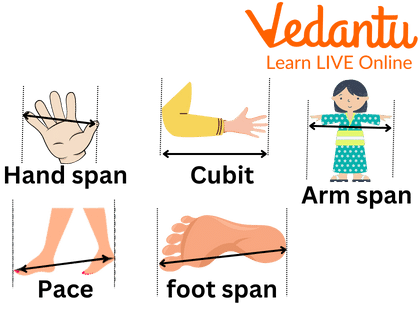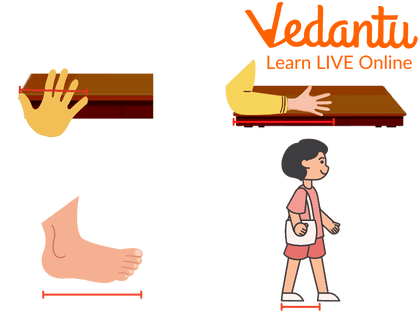




Measuring System - Introduction
A measuring system is a set of units of measurement and the rules that affect how they are related to one another. The term "measurement" comes from the Greek word "metron," which means "a small amount." In the past, humans utilised bodily parts for informal measuring systems such as foot length, cubit, handspan and so on, which were inaccurate and varied from person to person.
What are the Different Ways of Measurement?
The measurement of length of an object or distance covered can be measured using standard and non-standard ways.
Standard Measurement: The length measured using the metric system or using the defined units comes under the standard way of measurement. In these units like metre, kilometre, centimetre, decagram, and milligram are used.
Non-standard Measurement: The measurement using the body parts of the person comes under the non-standard way of measurement. The body parts like arms, hands, feet, and elbows are used for this. This is not an exact way to measure things as the length of the body parts is different from one person to another.

Non-Standard Method of Measurement
Handspan Measurement
Handspan measurement is done using the palm of the hand. The distance between the tips of the thumb and the tips of the little finger on an open palm is taken into account. The length of the palm of the hand is different for every person. It can be used to measure the length of your books or your water bottle. Long distances like the distance from your school to your home can’t be measured using the palm of your hand.
Cubit Measurement
The cubit length or the length from the elbow to the tip of the fingers can be used to measure length. The cubit measurement can be used to measure objects like clothes, tables, beds and chairs but cannot be used for the longer distances of large objects like walls.
Footspan Measurement
The foot span measurement is done by the tip of the toe and the heel of the foot. The floor can be measured using this type of measurement but it would be very time-consuming. The length of the foot is different for every person and the measurement done using this can vary.
Pace Measurement
Natural walking can also be considered a way to measure distances. Pace measurement or stride measurement is taken by placing the right foot forward followed by the left foot. The footsteps can be counted easily and large distances like the distance from school to home can be measured using pace measurement. But if there is a change in the length of the pace being followed, then it could lead to a wrong calculation of the distance.
Arm Span
Arm span or reach is the physical length measured from one end of an individual's arms (measured at the fingertips) to the other when lifted parallel to the ground at shoulder height at a 90 angle (also referred to as wingspan, or written arm span). We'll use our arm span as a reference to measure the length of the fabric. When determining height, the arm span is sometimes used.

Measuring Objects Using Different Methods
Sample Questions
1. What can be used to measure the length of an object?
Vegetable
Fruits
body parts
Clothes
Ans: Body parts
2. Length of a table can be measured by?
Palm of hand
Foot
through pace measurement
None of the above
Ans: palm of the hand
3. The standard measurement is done using the?
Ruler
Inchtape
metre stick
All of the above
Ans: All of the above
Conclusion
The objects and the distance can be measured using the standard and the non-standard ways. The non-standard ways are not very accurate and would change from person to person. The standard methods are accurate and we can change the unit of the length according to the units that we need.
FAQs on Measuring System
1. You visited a cloth shop and selected the cloth of your choice. You asked the shopkeeper to give you 4 yards of the fabric. Among the handspan, cubit and arm span, which one would be used by the shopkeeper to measure the cloth?
The shopkeeper would use an arm span to measure the cloth as it is the largest unit of measurement among handspan, cubit and arm span.
2. Identify the non-standard unit of measurement from the list:
Scale, eraser, pencil, measuring tape, book, protractor, chalk
The non-standard unit of measurement can be done using an eraser, pencil, book and chalk.
3. Who gave the standard unit of measurement?
Gabriel Mouton gave the standard unit of measurement and founded the metric system that we use.
4. What is the length of a cubit in standard measuring units?
The length of a cubit in a standard measuring unit is approximately 18 inches or 46 centimetres. The length can be measured using a measuring tape by keeping the start point at the tip of the middle finger and the end point at the elbow.
5. How many hand spans are there in a cubit?
There are approximately 2 handspans in a cubit.











